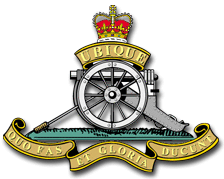
Ashtead War
Memorials - WWI - Gnr William Henry Childs MM
D Bty, 46th Bde, Royal Field Artillery

William’s parents were Thomas Childs [born Yetminster, Dorset, registered? Sherborne 6/1854, as Tom Childs] and Martha Elizabeth née Rouse [born Stoke by Nayland, Suffolk, registered Sudbury 3/1850] whose marriage was registered on the Isle of Wight for the September Quarter of 1875. They had two children before the birth of William Henry Childs, registered IoW 9/1883.
For 1881, Thomas Childs may be found enumerated at Bartletts Green Cottage, Brading, Isle of Wight, Hampshire, employed as a Gamekeeper, but by 1891 he had moved to Compton, West Sussex, then described as Woodman, and in 1901 had arrived at Ashtead’s Warren Cottages, becoming an Estate Forester.
Before he reached the age of 18, William left home to find employment, in the service of Baroness Ashburton, at The Grange, Northington, Arlesford, Hants., as a Stewards Room Boy. Soldiers who died in the Great War suggests that, at the outbreak of WWI, he was living in Southampton [1911 Census Petersfield] but came back to Ashstead [sic] in order to enlist in Royal Horse & Royal Field Artillery. Over the years 1914-1918, his father figures in Ashtead Street Directories, resident in Grove Road.
As Gunner 8626 RFA, he arrived in France on 9 February 1915 to join D (H) Battery that was attached to XLVI Brigade, 14th Division. A Supplement to the London Gazette of 9 December 1916, page 12043, records his award of a Military Medal but a citation has not been traced and it is impossible to say when the act of gallantry took place.
He carried on to be killed in action on 23 September 1916 presumably towards the end of the Battle of Flers-Courcellette. This had begun on 15 September 1916 and lasted for one week, as the third and last of the large-scale offensives mounted by the British Army during the Battle of the Somme. The battle was significant for the first use of the tank in warfare and expectations were high that it would prove a decisive weapon. However, the Mark I tank's performance in the battle was patchy and the British commander-in-chief, General Sir Douglas has been criticised for revealing the secret weapon too soon.
William was eventually interred in Quarry Cemetery, Montauban, which was begun (at an advanced dressing station) in July 1916, and used until February 1917. The Germans buried a few of their dead in Plot V in April and May 1918. At the Armistice it consisted of 152 graves in the present Plots V and VI. It was then increased when graves (almost all of July-December 1916) were brought in from the battlefields and small burial grounds surrounding Montauban. The following are burial grounds concentrated into this cemetery: Briqueterie Cemetery No. 3, Montauban, was on the east side of the brick-works on the Longueval-Maricourt road. It contained the graves of 23 soldiers (mainly 1/5th King's Own Royal Lancaster's) who died in July and August 1916. Caterpillar Wood Cemetery No. 2, Montauban, was at the east end of Caterpillar Wood, north-west from Montauban village. It was begun by the 2nd Suffolks and contained the graves of 50 soldiers who died between July 1916 and January 1917. Green Dump Cemetery, Longueval, 1.2 kilometres west of Longueval village. It contained the graves of 54 soldiers who died between August and October 1916. Quarry Scottish Cemetery, Montauban, was between the Quarry and the north end of Bernafay Wood. It contained the graves of 55 soldiers (largely 11th and 12th Royal Scots) who died in July 1916.
text: Brian Bouchard: if you can add to this page please contact the editor
page added 29 Mar 2009